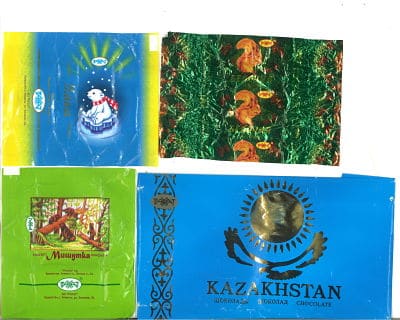“It has become a fashion to regard any vestige of the USSR through the framework of nostalgia. The sentiment is –there could not have been anything valuable about socialism, and anybody who remembers it in a positive light is clearly engaged in self-indulgent idealization of the past. Another off-shoot of this attitude is to regard the artifacts from the socialist life in terms of kitsch — as an amusing and ironic extension of capitalist consumerism. The Rakhat candies from Kazakhstan exemplify an artifact that disrupts this perception. It is neither a nostalgic or kitschy legacy from the Soviet past. Rather, it is one of the real continuities that survived despite the vagaries of the economic collapse of the 1990s. Produced by the joint stock company “Rakhat” in Almaty that took over from the Alma-Ata Candy Plant (Alma-atinskaya Konditerskaia Fabrika) in the first decade after the dissolution of the Soviet Union, these candies represent the best chocolates from the Soviet period.”
In contrast to mundane American Nestle or Cadbury chocolates that routinely assault customers at the check-out lines at the supermarkets and drugstores, the Soviet chocolate candies (Mishka na Severe, Krasnaya Shapochka, Belochka, and Gril’yazh) had been prized and displayed on the tables only for most celebrated feasts. Children got to know these candies as the treasured New Year gifts that they received from the Father Frost during their celebrations in schools and kindergartens.
The post-Soviet privatization brought havoc into production of these candies. One of the trickiest issues, I learned in Almaty, was to solve was to how to divide the ownership over the copyright and intellectual rights over these candies. In the Soviet Union, there had been several plants manufacturing these same candies (including in Russia, the Ukraine, and Kazakhstan), and after the privatization of these plants, the challenge was to decide who inherits what. Whereas the Moscow factory claimed the name of these candies, the Almaty factory inherited the Soviet design of the candy wrappers.
However, the company continued not only with the design but also with the flavor of the candies. Despite the access to proliferating brands of new exotic candies in post-Soviet period, most people in Kazakhstan still preferred the familiar Soviet candies produced with the same unchanging flavor by the Rakhat factory. When I tried these candies, I was not surprised – the middle of candy was a crispy waffle layered with cream and surrounded by chocolate where one could taste the high content of cacao. Every time I leave Kazakhstan, I am handed kilograms of these candies to take home to America with me – not because of any nostalgic or political sentiments but because the candies are genuinely good and my hosts want me to take the best.
These findings have come to me during my time spent in Kazakhstan as part of the Artpologist art collective. The collective created several projects engaging the everyday life in Central Asia. Ethnographic attention to the mundane lives of people making a living in the aftermath of the dissolution of the Soviet Union has provided us with an insight into many unexpected discoveries about socialism on the ground. As Americans brace the challenges of consumerism, the environmental effects of capitalism, and neoliberalism, I believe that there is still much to learn from exploring the legacies of socialism on the grass-roots level.
Daniel Gallegos is an artist born and raised in the San Francisco Bay Area. He is a member and co-founder of the Artpologist Collective, a network of artists and anthropologists that engages in ethnographic exploration of urban spaces and everyday lives of communities in the post-Cold War-era world. You can follow their work through their Facebook profile or their website: http://artpologist.com






